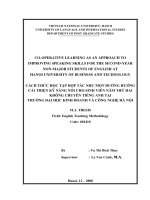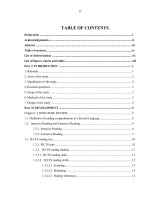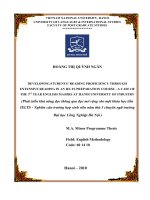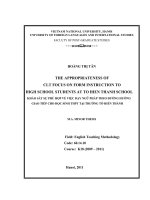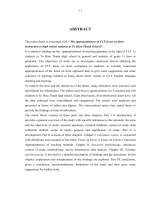SKKN examining the plausibility of extensive reading as an approach to learning english at a secondary school context
Bạn đang xem bản rút gọn của tài liệu. Xem và tải ngay bản đầy đủ của tài liệu tại đây (254.88 KB, 14 trang )
Her students’ increasing
need for
exposure to more authentic language
input, together with the writer’s wish
to boost those students’ autonomy
has led to this theoretical examination
of the plausibility of introducing
Extensive Reading into her teaching
context - a tracking school for the
gifted in Vinh Yen, Vinh Phuc.
BÁO CÁO
CHUYÊN ĐỀ
HỘI THẢO
Examining the plausibility of
Extensive Reading as an
approach to learning English
at a secondary school context.
TRAN THI THUY
Contents
Part 1: Introduction..................................................................................................................................... 2
1.
Reasons for choosing the study.................................................................................................... 2
2.
Aims and significance of the study............................................................................................... 2
3.
Subjects of the study...................................................................................................................... 3
4.
5.
Limits of the study.......................................................................................................................... 3
Methodology.................................................................................................................................. 3
6.
Research time................................................................................................................................. 3
Part 2. The Study......................................................................................................................................... 4
1. Extensive reading: A definition.......................................................................................................... 4
2. The benefits of extensive reading..................................................................................................... 4
3. Principles of an extensive reading programme............................................................................... 6
4. A model of an extensive reading club in Vinh Phuc senior secondary school for the gifted .......7
REFERENCES................................................................................................................................................... 12
1
Part 1: Introduction
1. Reasons for choosing the study
Various attempts at different levels have been made to improve the quality of
teaching and learning English at school. In fact, the Ministry of Education and
Training has recently suggested that by the year 2020, at least half of the young
should be able to use English fluently, and this is a goal for teachers of English
and education authorities to work towards. The main challenges lay, however, in
the lack of human resources to cater for such need and the lack of motivation to
learn English from the students.
In a workshop in 2011, the writer was exposed to Extensive Reading, an “aid to
language learning” which has been reported to work in many an Asian countries.
By doing a great amount of reading under the language teacher’s instruction and
facilitation, students are claimed to make steady progress in all language
components and language skills. It is therefore believed that extensive reading
can be the key to language improvement which may be appropriate in our
educational setting, since it provides an alternative to the more common teachercentred mode in Vietnam and can hence deal with the two aforementioned
issues effectively. Implementing a programme of extensive reading in a particular
school, however, needs elaborate preponderance. This study is therefore to serve
as a theoretical basis for the official formation of an extensive reading club
within a senior secondary school for the gifted in Vinh Phuc.
2. Aims and significance of the study
The study aims to provide a conceptual overview of Extensive Reading and
examine the relevance of this approach in a special senior secondary school in
Yenbai. This review and examination may subsequently encourage similar
schools in the area to consider including extensive reading into their
teaching/learning, either as part of a required curriculum or as an extracurricular programme.
2
3. Subjects of the study
This being a theoretical review, the primary subject of the study is the vast
amount of literature on extensive reading. Besides, there are 20 students
participating in the informal discussions on their study needs and study
preferences.
4. Limits of the study
Should there be sufficient resources for an actual pilot implementation of the
programme to support the review, this study could be considerably improved.
5. Methodology
The study involves reviewing and summarising the literature on extensive
reading. This is followed by observation of and informal conversations with 20
students in an advanced English class in the school.
6. Research time
March 2014 –February 2015
3
Part 2. The Study
1. Extensive reading: A definition
Extensive reading is understood as an approach to language learning/teaching
which is “generally associated with reading large amounts with the aim of
getting an overall understanding of the material. Readers are more concerned
with the meaning of the text than the meaning of individual words or sentences.”
(Day &Bramford, 2002).
2. The benefits of extensive reading
Bell (1998) summarised a number of advantages of extensive reading, from positive
psychological aspects to real language enhancement, of which the most important are
listed below:
a. The provision of authentic, 'comprehensible input'
It has always been proposed that that extensive reading will lead to language
acquisition, provided that certain preconditions are met, including adequate exposure
to the language, interesting material, and a learner-friendly environment.
b. The enhancement of learners' general language competence
Extensive reading increases the opportunity for the learner-reader to practise his
automaticity of word recognition and decoding the symbols on the printed page (often
called bottom-up processing). In a study on an extensive reading project with school
children by Elley & Manghubai (1983), significant post treatment gains in word
recognition and reading comprehension was reported to be gained after the first year,
and wider gains in oral and written skills after two years.
c. The increase of the students' exposure to the language
It is a fact that the quality of exposure to language that learners receive is of great
importance to their ability to acquire knowledge, whether in terms of grammar or
lexico, from the input. Elley’s (1991:404) research subjects in an extensive reading
programme showed rapid growth in language development compared with learners in
regular language programs. He claimed to have seen a "spread of effect from reading
competence to other language skills - writing, speaking and control over syntax,"
4
d. Increased knowledge of vocabulary
It is suggested that only a small percentage of vocabulary learning is due to direct
vocabulary instruction, the remainder is acquisition of words from reading. Traditional
approaches to the teaching of vocabulary, in which the number of new words taught in
each class was carefully controlled (words often being presented in related sets), is
therefore not sufficient in promoting vocabulary growth. Exposing leaners to reading
text can fill in the gap.
e. Improvement in writing
With such regular peruse of “comprehensible input”, there have been reported
significant improvements in subjects' written work. Extensive reading is accordingly an
effective means of fostering improvements in students writing.
f. Increased motivation for learners to read
As Bell (1998) put it “reading material selected for extensive reading programs should
address students' needs, tastes and interests, so as to energize and motivate them to
read the books”. With some need analysis in advance, the organiser/teacher can easily
identify the appropriate genre(s) for their students to read, for example by means of
informal discussion or the delivery of a need analysis questionnaire. In many cases,
familiar material and popular titles reflecting the local culture, or, paradoxically, stories
of faraway land and strange customs and practices could be the most popular among
school children and even teenagers.
g. The consolidation of previously learned language
The authentic, or near-authentic choice of books to read also mean that by reading
students can experience what is termed the “recycling” of language. This is by itself a
form of reinforcement which helps to ensure that new input is “retained and made
available for spoken and written production” (Bell, 1998).
h. The building up of confidence with extended texts
It is the case that all classroom reading work in our course books are traditionally
focused on the exploitation of shorts texts. Gradually the average student could be
accustomed to reading those “simple-looking” texts that he/she would back up when
asked to read longer, more complex ones for academic purposes. Extensive reading can
5
therefore provide a “fun”, stress-free approach to the acclimatisation of students with
these longer texts.
3. Principles of an extensive reading programme
Drawing on their experience with different extensive reading programmes, researchers
(Day, 2002; Bramford, 1998; Maley, 2008) have proposed a number of criteria on which
to develop a standard programme which could be useful for future reference. Some of
the most widely known and well supported ones are as follows:
a. Maximize Learner Involvement
This is meant to reduce the feeling of obligation which may impede students’
automaticity both during the whole programme and during their individual act of
reading. Particularly, students should be encouraged discuss with the teacher to identify
their own interest in reading, for instance, whether it is books about the
environment/space or fiction books. For students in Nguyen Tat Thanh senior
secondary school for the gifted, this involvement is highly desirable. From a
psychological point of view, most of the students here, being teenagers, have very strong
face-saving needs and the teacher’s failure to give them a sense of “ownership” of their
reading project may cause feelings of compulsion and later dissatisfaction.
b. Provide a wide range of texts
It is strongly believed that some variety in terms of genre and length of texts can
minimize the student’s chance of feeling bored. For the success of any lengthy project,
there should be abundant reading materials available in a range of genre and length.
The teacher should note, however, that whatever type of material, the language
presented must be within the language competence of the reader-student.
c. Avoid the Use of Tests
As testing in our context is often associated with rote learning, memorization and lack
of freedom, extensive reading done at home or during an agreed period of time assigned
should be totally detached from testing.
6
d. Discourage the Over-Use of Dictionaries
Dictionary use may harm the flow of the reader if she/he concentrates too much on
looking up the meaning of every single new word. Pickard (1996:155) comments that,
for the extensive reader-learner "Use of the dictionary was sparing, with the main focus
on meaning". Similarly, Day (2002) suggests no dictionary use during reading as most of
the chosen material should be “comprehensible input”
e. The teacher’s role
There is a shift in the roles that the teacher plays in an extensive reading programme
with those she/he does in a normal classroom setting. He/she no longer directs the
students’ learning. Rather, she/he facilitates it. Besides, Bramford (1998) points out that
in order to administer the resources efficiently, and to trace students' developing
reading habits and interests, effective monitoring from the teacher is fundamental.
f. Maintain the Entertainment.
This is in fact the key to any extensive reading programme. Only when students are
delighted with what they are doing can they continue with their work. Once the fun is
kept, automaticity and self-adjustment along the way can be more feasible.
Entertainment can be achieved by different ways yet the vast amount of responsibility is
on the teacher as a facilitator. Her/his creativity, suitable follow-up activities, good
management skills may help.
4. A model of an extensive reading club in Vinh Phuc senior secondary school for
the gifted
The above analysis of the literature on extensive reading has made a case for an
extensive reading club to be set up in the next school year. Below is a step -by-step
proposal for such a project.
a. Membership intake
It is suggested that membership should be open to everyone, but should
primarily target at English-majored 10 graders who may have more motivation
to persevere with the project. My observation and informal conversation with
students from different grades has confirmed me that for 11 or 12 graders the
amount of time required by the project may be a source of pressure for them as
7
they are approaching multiple exams (the university entrance exam, the regional
and national academic competitions). In addition, those English majored 10
graders, being fresh from junior secondary school, may wish to become part of a
society sharing common interest and doing something special. In other words,
they can be more readily involved and easily motivated. For this new reading
club, the number of member should not exceed 15. This limitation is justified by
the fact that the smaller the group, the easier it is for the inexperienced teacher
to monitor and facilitate.
b. Raising fund
For the project to work, the teacher has to make sure that the “comprehensible
input” students get exposed to is abundant and validated. This means at least
200 books need purchasing from reliable publishers. The finance for the buying
and locating of those books may come from different sources, namely:
PTA: A sensitive issue, yet, most feasible in our school context where
many parents can be willing to support such a programme, especially those
whose children are members of the club.
ERF: The extensive reading foundation also offers some financial support
to certain reading programme. A proposal on the programme, including the
detailed budget should be submitted to the grant committee for consideration.
c. Need and Competence analysis
An informal meeting among the members and teacher could easily help identify the
kinds of books to be purchased. There is a wide range of choice covering almost
every genre, from poems to adapted novels to suit the learner-reader’s needs.
However, the members’ competence has to be examined carefully by means of
testing their speed of reading comprehension. With students being at around the
same grade, it is supposed that the levels of their competence are more or less the
same. Again, automaticity should be encouraged. In other words, students are given
freedom to decide for themselves which level of difficulty is the most suitable for
him. The analysis has implications for the purchase of materials. All extensive
reading materials are graded according to their levels of difficulty (see the sample
8
attached on page 14). If, for instance, the students are comfortable with reading a
text at level 4, then she/he should buy only those from level 4 and up.
Prior to the discussion and competence analysis, the teacher should prepare a form
to note down all those needs (see below)
Name
Genre 1
Genre 2
Level
d. Purchasing/ Accumulating material
Books for extensive reading can be purchased from major bookshops in Hanoi and
Hochiminh cities. Furthermore, a variety of texts and audio specifically designed for
the purpose can be downloaded online for free. Please find attached on page 14 a
sample provided.
e. Other arrangements: time, location, regulations
These should be talked through and agreed upon among the members with the
teacher playing the role of a key member willing to offer help and a more “global”
vision.
f. Extensive reading: 1st cycle
The club will last for all the three years of the student’s senior secondary school.
After each year, reflection is necessary and more books can be bought to keep up
with the improvement in the students’ language competence. During the time,
the following should be noted.
9
Monitoring from the teacher
The previously mentioned no-test rule does not mean that follow-up
activities are excluded from the project. On the contrary, they are crucial
in the teacher’s effort to monitor the students’ performance and progress.
Below are some highly recommended activities by Bramford (1998) and
Day (2002)
The Reader Interview
Regular conferencing between teacher and student on what they have
read and on their opinion on the book.
Read Aloud to the Class/ Use of audio books
The teacher may need to read some favourite extracts outloud to the class
and then share his/her thinking on the parts. This act provides a model of
how to correctly pronounce a word and how to read with emotion.
Students then can follow. In cases when the teacher is not comfortable
with reading out loud, the use of an audio book may help.
Student Presentations
Short presentations on books mean more opportunities to practise
speaking skills in a highly authentic context. IN similar projects, it has
been observed that most of the book choices made by students resulted
from recommendations made by friends, not by the teacher. Given the
right preparation, encouragement, sense of ownership and belonging, an
extensive reading program will achieve a direction and momentum
governed by the learners themselves; a large step in the promotion of
student independence and autonomy.
Follow-up written reports/ blurbs/ reviews
Contests can be organised in which students choose on their own to write
a report on a book they have read or an alternative blurb to the one used
by the publisher.
10
Part 3. Conclusion
The study seeks to provide some insights into extensive reading, focussing on
highlighting the benefit and relevance of extensive reading in our educational setting.
From this a plan has been suggested for the next academic year.
Due to the limited experience in this field from the writer, and the limited time possible
for the review of the literature, problems and oversights are unavoidable. I therefore
would be grateful to any comments and criticism from the readers for the betterment of
this study.
11
REFERENCES
Bell, T, (1998) Extensive Reading: Why? and How? The IESL Journal, 12 (4)
Day, Richard, R. (2002) ‘Top Ten Principles for teaching extensive reading.’ Reading in a
Foreign Language. 14(2)
Day, Richard, R and Bamford, Julian.(1998) Extensive Reading in the Second Language
Classroom. Cambridge: Cambridge University Press.
Elley, W. B., & Manghubai, F. (1983). 'The effect of reading on second language learning.'
Reading Research Quarterly, 19/1, (pp 53-67).
Maley, Alan (2008) ‘Extensive Reading: Maid in Waiting’ in B. Tomlinson (ed) English
Language Learning Materials: a critical review. London/New York: Continuum pp133156
12
Appendix 1: Sample of a reading text.
Genre: Literature. Grade 5
The Devoted Widow
A widow weeping on her husband's grave was approached by an Engaging Gentleman
who, in a respectful manner, assured her that he had long entertained for her the most
tender feelings.
"Wretch!" cried the Widow. "Leave me this instant! Is this a time to talk to me of
love?"
"I assure you, madam, that I had not intended to disclose my affection," the Engaging
Gentleman humbly explained, "but the power of your beauty has overcome my
discretion."
"You should see me when I have not been crying," said the Widow.
(Ambrose Bierce)
13


